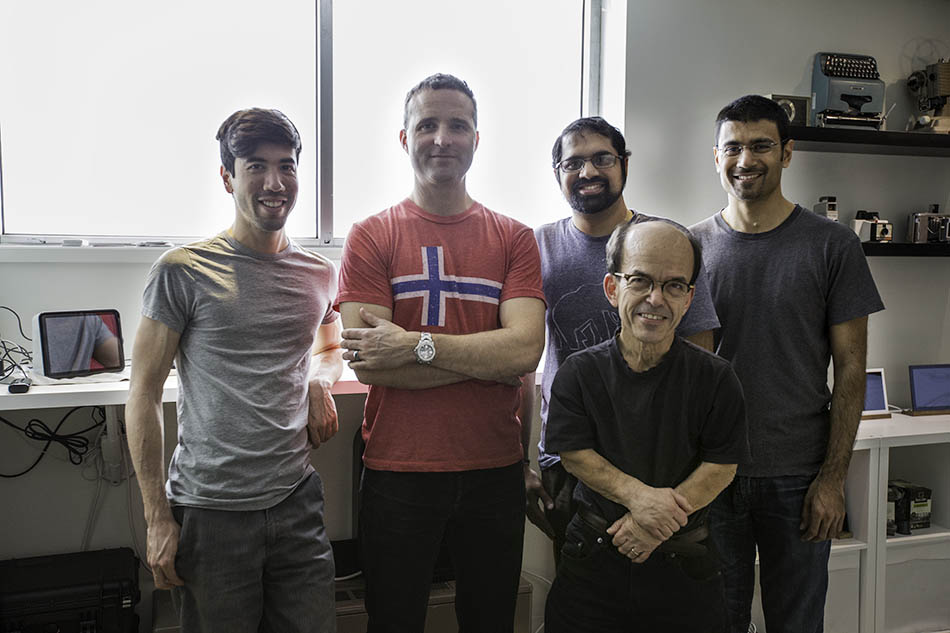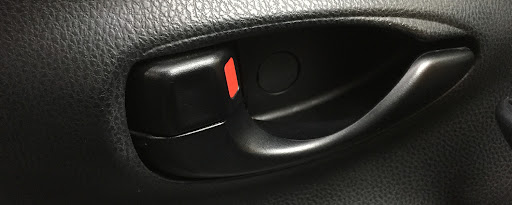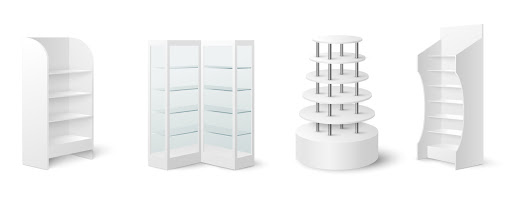Time to read: 8 min
We live in a world replete with devices. Tablets, smartphones, desktops, laptops, smart watches, cars, TVs, thermostats, door locks. Probably toasters soon, too. Surely we don’t need another “thing.” Surely, if we want to do something as simple as browse through our photos, we can just pull up our tablets, smartphones, or plug our camera straight into our smart TV.
But the people at Loop would beg to differ. Sometimes, you do need a separate device—one dedicated solely and completely to one thing, and to doing that one thing extremely well.
In this Spotlight, co-founder and head of design Ethan Ballweber shares with us the company’s thinking behind Loop, a personal image-sharing device for all generations.
A New Way to View Our Images
Remember the digital picture frame? That horrid-looking black plastic frame with a really poor quality screen? Enter Loop, a stand-alone interactive display for photos and videos. Its design and functionality are light years beyond that first plastic frame.

Ever since the advent of digital cameras, which exploded everyone’s capacity to produce images, the problem has always been glut and obscurity: we all have way too much photography on our hard drives/mobile devices/clouds; we don’t have the time to edit and organize the images and videos, and there’s no easy way to display or share them. Sure, you can set up Instagram and Flickr accounts, but then anyone else you want to see them (say, your older relatives) has to have access to a computer or mobile device. You can email them, but then they either don’t get opened up, or they’re viewed a whopping one time before they drown in the relentless stream of email. You can print them, but… no need to go into what that entails.
As Ethan explains, “We wanted to create a device for displaying images that fits within people’s lifestyle. For some people, all the technology out there is just too much work. They don’t want to have to download the images and then attach them to an email or upload to a website. So we asked ourselves, how can we connect people with their photos in a way that works for them, that makes it easy for them. You can’t just stream them directly into the device because that would create the same backlog of photos.”
Contrary to what some might think, Loop isn’t about disrupting yet another industry—in this case, the multi-billion-dollar digital frame industry (we’re not kidding about the billions). It’s actually about soothing the consumer in a hyper-evolved tech environment. Yes, it is a new physical device, but its function and its very reason for being are about dialing down the multi-tasking, attention-splintering functionality that’s all around us all the time.
“The question we always asked,” says Ethan, “was how can we simplify [our device], how do we wrap it up in a framework to make it a different experience from the tablet. The tablet is about rich interaction and versatility—but for solo use, since you’re holding it in your hands. Loop is a hands-free device for more passive or lightweight consumption that you can share with other people.”
What Does Your Hardware Wear?
In the beginning, Loop’s founder Brian Gannon applied to the Highway1 accelerator. The original product that came out of that accelerator was, in Ethan’s words, “much more minimalist” than their current product. It had an aluminum enclosure with a walnut base, and was heavily furniture-inspired: “we chose premium materials and based our design inspiration on mid-century modern furniture.”
That was what Ethan calls Concept Zero.
The team ran into their first challenge immediately. “Concept Zero got respect,” Ethan explains. “It was well made, but it wasn’t necessarily for everyone—it wasn’t ‘friendly,’ and didn’t let people express their personality. It appealed more to designers.”
Another issue was sourcing the materials. “Walnut is difficult to find, and that makes it hard to manufacture on any sort of scale. One of our advisors challenged us to do something better. Something great. To make [Loop] more friendly, approachable and iconic.”
So for two weeks, they put everything else on hold and focused exclusively on design. They took everything into consideration, including the 1950s and 60s televisions and radios from their own original inspiration boards.
“We produced seven new prototypes in those two weeks,” Ethan tells us. “And that’s how we came up with our current version, Concept Three.”
The knob introduced in this new concept solved not only a user interface problem, but also a content management problem—that of organizing all of the images and videos on the device. The answer was channels. Just like on the good old TV set.
“People thought we were crazy,” laughs Ethan. “Everyone else in the world was chasing Apple to make things as thin a possible, and we went the other way and made a product with substance. Ironically, over time as it got more and more refined, people began to fall in love with it.”
To 3D print their prototypes, Loop “worked with Fictiv the whole time. We did about six studies of the enclosure itself, with several deep-dive studies, and we used that to judge size, proportion, thickness, and ergonomics.”
In the process, Ethan and the team realized that works of art do not necessarily translate to a great user experience, or to manufacturing at scale. “Design and materials are closely related: sometimes it’s about the material and sometimes it’s about the form. Concept Zero was about the material, and Concept Three is about the form.”
Why UI Really Does = UX
The average person probably doesn’t think twice about what it took to design their favorite gadget. About the countless iterations, all the prototypes and features that failed. Great design is, as the pros say, invisible. If you notice a functionality (as opposed to using it intuitively), there’s something wrong with the product.
Smartphones and tablets don’t have knobs and straps; they have a sleek, ergonomic profile and a virtually indestructible touch-screen. There’s a reason for that: we use them literally hundreds of times a day; any knob or strap would likely fall off, break off, or be ripped off sooner or later. But a device like Loop is no smartphone or tablet, and interacting with it is not the same as holding either one. It has a heavier bottom, two knobs on the side to navigate through images and select channels, and a lever on the lower back that works like a light dimmer to control the brightness of the screen.
“We found that tapping an upright-standing device would knock it over, or at the very least it would feel flimsy. It just doesn’t feel right,” Ethan tells us. Of course any issue can be solved, but the team wanted to communicate that this really is a different product from the others. “The knob communicates that message visually,” he says. “Sure, it’s a more traditional mechanism, but newer design is not always ‘better’ design. Tapping and flipping through photos is not efficient. There’s something fun about the tactile experience of actual knobs on devices.”
To carry that tactile experience all the way through, the team purposely synched the frame animation on Loop’s screen with the knob so that when you turn it, the photos (or videos) slide up or down and seem to click into place. If the device is set to auto display, the transitions between images are cross-fade so it doesn’t distract.
“Unlike other digital displays, we want the screen to mimic print,” says Ethan. In fact, Loop can tell when the light (artificial or natural) in the room grows dim, and its screen dims accordingly—largely to avoid that sense of yet another tech device in the house emitting light.
Then there’s the leather strap, an actual strap on the back of the device that enables people to carry it around. “The concept here is fun and delight and intrigue,” explains Ethan. “Makes you want to play with it, and tells you that Loop is approachable and friendly, not a fragile piece of high tech stuff you’d worry about dropping and cracking.”
Comfort and Novelty: Can We Have It Both Ways?
His voice tinged with genuine empathy for the older generations, Ethan shares that Loop is about both novelty and comfort. “For the younger generations, it’s novelty, it’s retro. For the older generations, it’s about comfort, about not having to bend your brain every time a new piece of technology comes out. I’m also starting to appreciate some of that old stuff that didn’t feel like it went out of date every week.”
Creating a brand new device that appeals to all ages requires walking a bit of a tightrope. You want uniqueness and originality, fun and play and freshness of spirit (a rockin’ UI). But you also want what we call “extreme user friendliness”—a design whose functionality is so painfully obvious and familiar that even your grandmum can roll with it.

Ethan heartily agrees. “Everyone is comfortable with knobs. People reach out naturally to turn the knob without the fear of breaking it like with a smartphone. It’s a different object, which calls for a different psyche and mental construct.
“It’s important to have little bits of our own character,” he adds, “but we also need to take the accepted conventions for photo sharing into consideration and determine how we can best integrate that into Loop.”
The company has tested the product with their own families, and is seeing equal levels of comfort among all generations. “The recipient [of photos or videos sent] doesn’t have to do anything, which they love,” says Ethan, “and the sender shares on their own terms.”
Similar to the concept of an album, users can organize their photos and videos into channels, which can be shared or made private. The channels are linked to dynamic sources like Instagram, Facebook, or Dropbox iOS Photos, which automatically update the channels with fresh images coming in from the user side, so there’s more than one way to flow your photography into Loop.
Breaking the Habit of Excess: Can We, and Should We?
The question for Loop remains, will they keep the product devoted to photography and videos or will they succumb to the ever-present temptation of “doing more”?
Ethan laughs. “Everyone always asks us, will Loop do more? Like, play music videos, or see online content, or someone else’s photos the way you can on Flickr. The new design [of Concept Three] wraps it around the personal television concept, which lets you tune into things you want to see even if you’re not paying explicit attention to them.”
Okay, but will Loop ever multi-task?
“We haven’t made up our minds yet what else, if anything, this device will do. Brian and I come from a background that focuses on nailing that one thing, and as a startup, you do have to stay focused. At the same time, we are running powerful hardware, and with that the walls that come with traditional, non-software products really break down. So we’re curious about what has yet to come and what we can connect to in an elegant way.”

